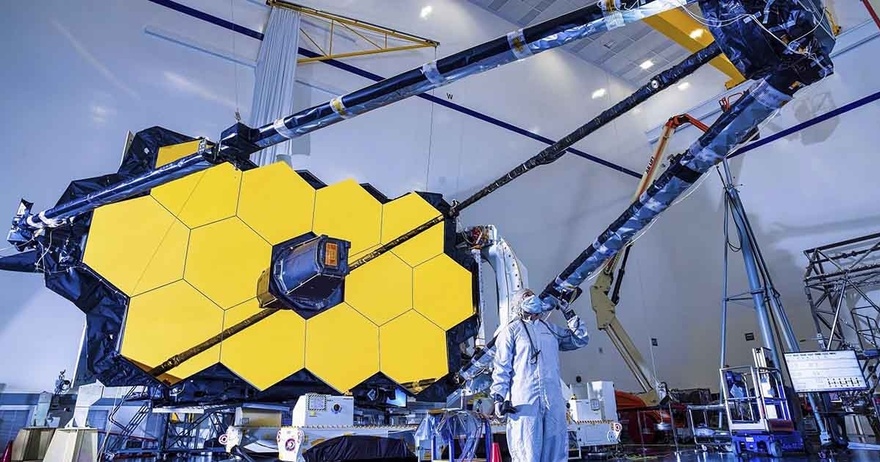In an extraordinary breakthrough, astronomers using the James Webb Telescope detected a molecule that, at least on Earth, comes only from living organisms. This 2023 discovery, made while studying a distant exoplanet, has sparked excitement across the scientific community and renewed the search for life beyond Earth. The James Webb Telescope, known for its groundbreaking capabilities, continues to push the boundaries of what we know about the cosmos, and this latest finding has captivated scientists and the public alike.
The key finding? Dimethyl sulfide (DMS) — a compound produced solely by biological processes on Earth. While scientists remain cautious, this detection offers one of the strongest clues yet that alien worlds might host life. Researchers found DMS while studying K2-18b, an exoplanet about 120 light-years away in the constellation Leo. This planet orbits its star within the “habitable zone,” meaning conditions might allow liquid water to exist.
Could This Mean Life on Other Planets?
Using its powerful instruments, the James Webb Telescope picked up hints of DMS in K2-18b’s atmosphere. On Earth, phytoplankton — tiny marine organisms — produce DMS, raising a thrilling possibility: could life exist on this distant world? Researchers also found methane and carbon dioxide, suggesting K2-18b might be a “hycean” planet, covered in oceans with a hydrogen-rich atmosphere. Such an environment could provide the right conditions for life to thrive.
The data revealed that K2-18b’s atmosphere has a relatively low level of ammonia, supporting the idea that a large water ocean could exist beneath the planet’s thick hydrogen envelope. This intriguing combination of atmospheric traits strengthens the case that K2-18b might harbor life.
Dr. Nikku Madhusudhan from the University of Cambridge, who led the research, noted, “This is the first time we have ever detected such a molecule on a planet outside our solar system.” However, he stressed the need for more observations to confirm the finding. Detecting molecules by analyzing light through thick alien atmospheres is tricky, and researchers continue gathering data to verify the molecule’s presence.
Searching for Life Beyond Earth
When scientists hunt for life beyond Earth, they don’t expect to find advanced civilizations. Instead, they look for “biosignatures”— measurable signs that biological processes are at work. According to NASA, a biosignature could be a gas like oxygen, ozone, or methane in a planet’s atmosphere. These gases often appear when living organisms interact with their environment.
Scientists also study planetary conditions. As the European Space Agency explains, they look for liquid water, a stable atmosphere, and a steady energy source like sunlight or geothermal heat. Planets in the “Goldilocks zone“—not too hot and not too cold—make the best candidates. Finding life takes more than detecting one molecule. Scientists look for multiple clues that, together, build a strong case for life. Thanks to advances in technology, missions like the James Webb Telescope can spot these subtle hints more accurately than ever before.
How the James Webb Telescope Is Changing the Game
The James Webb Telescope launched with bold goals: study early galaxies, examine exoplanet atmospheres, and search for signs of life. In less than two years, it’s already delivering groundbreaking results. Webb detects tiny changes in starlight as it passes through a planet’s atmosphere. By breaking this light into a spectrum, scientists can identify different gases. This method, called transmission spectroscopy, lets astronomers sniff out potential biosignatures on planets many light-years away.
Beyond K2-18b, Webb has introduced us to the concept of “hycean” worlds. These ocean-covered planets could expand our definition of habitable environments. They might not look like Earth, but they could still support life. The detection of DMS on K2-18b marks a huge step forward. Even if further observations are needed, the James Webb Telescope has proven its incredible ability to detect molecules linked to life.
Proceeding with Caution
Despite the excitement, scientists remain cautious. Groundbreaking discoveries need careful verification. Other non-biological processes might mimic the signal attributed to DMS. Plus, atmospheric models for K2-18b are still in their early stages. Future observations will refine our understanding of the planet’s atmosphere. Upcoming missions, like ESA’s ARIEL telescope and NASA’s proposed Habitable Worlds Observatory, could help confirm these findings by studying exoplanet atmospheres in even greater detail.
Still, the detection of DMS remains one of the most exciting signs yet that life might exist beyond Earth. The possibility of simple microbial life living in alien oceans feels closer than ever before.
A New Era of Discovery
The discovery of a molecule like dimethyl sulfide on a distant planet marks a historic milestone. Humanity now has the tools to detect the chemical fingerprints of life across the cosmos. While the scientific community rightly urges caution, the findings on K2-18b spark hope. We might be inching closer to answering the age-old question: Are we alone?
As the James Webb Telescope continues to explore the universe, the possibility of finding life beyond Earth grows stronger. Maybe, just maybe, we aren’t alone after all.
